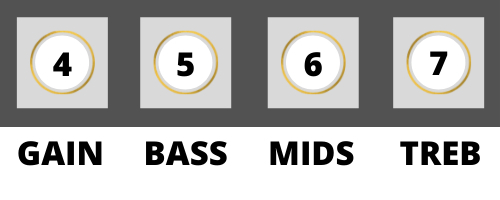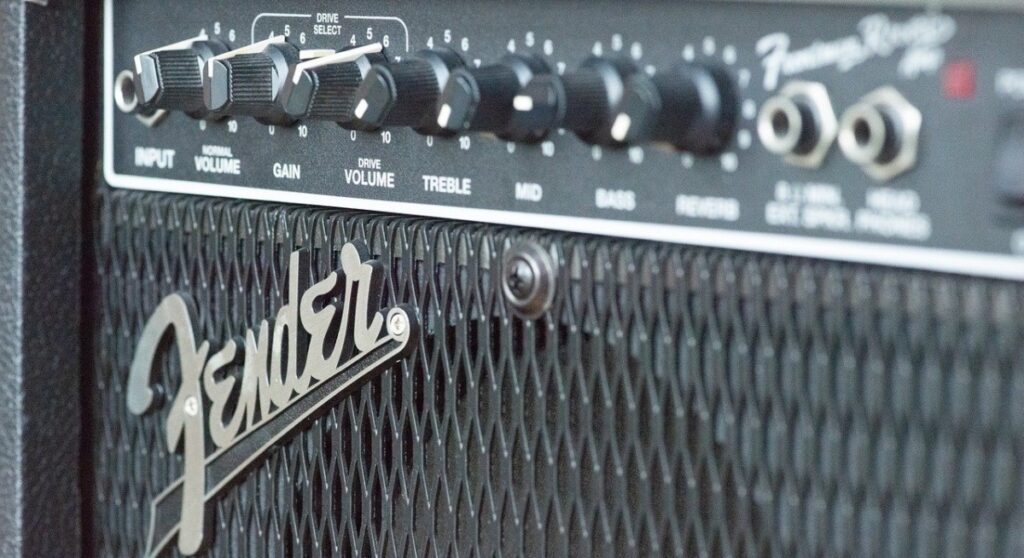The Rolling Stones are one of the most well-known Rock and Roll bands of all time with countless instantly recognisable songs. Guitarists Keith Richards, Mick Taylor, Brian Jones and Ronnie Wood all had an iconic tone that many players today want to emulate.
In this article, I’ll help you dial in the best amp settings to sound like The Rolling Stones on the electric guitar including example presets for their most popular songs.
Quick Guide to The Rolling Stones Amp Settings
To sound like The Rolling Stones on the electric guitar, start with the following amp settings:
- Gain: 3-4
- Bass: 4-5
- Middle: 5-6
- Treble: 6-7
Keep in mind that these example amp settings are just to be used as a starting point and unless you’re using the exact same rig as The Rolling Stones for a particular song, then it’s almost impossible to get an identical tone.
However, I’ve created this article to guide you through the process of achieving the closest possible tone with your current rig with plenty of tips and examples to help you along the way.

The Basics
Before we take a deeper dive into the example amp settings for different songs, I think it’s a good idea to get to grips with the settings required to achieve The Rolling Stones tone. There are three main types of setting to address here:
- Gain
- EQ
- Effects
Gain
The first thing we need to discuss, is the type of amplifier you’re using. If you have a solid-state amp (most reading this probably will), then you’re likely to have two channels (clean and distorted/ overdriven) and a control that’s called either gain or drive.
In this case, it’s usually best to select the clean channel and turn the gain up to 4 to begin with. This will allow you to achieve a grittier overdriven tone, but without it sounding too heavy. Some amps will not allow you to use the gain control on the clean channel, in this case, you can use the distorted channel but will only need the gain on around 3 for most songs.
If you have a valve (tube) amplifier, then you’ll want to crank this to just past the edge of break-up for most songs. They key is to get an overdriven, rather than a pure distorted tone for most songs.
The only other option, is if you are using a distortion or overdrive pedal instead of using your amp for the gain. This is possible with either a solid state or tube amp. In this case, you’ll want to make sure your amp sounds very clean and then use the pedal again to achieve some overdrive which will normally involve it being turned around a quarter of the way up.
EQ/ Tone (Bass, Mids, Treble)
Some amplifiers have separate bass, middle and treble controls, whereas others have a single control which is usually called either EQ or tone which essentially combines the three separate settings. Either way, these controls help to shape the overall tone and are very important.
The bass control adjusts the low-end frequencies and how warm the tone is. A higher bass setting will sound more warm and full, but also looser and sometimes too “boomy”. A low bass setting will make the tone sound thinner and brighter. In most cases, having the bass on 4 to begin with is about right. If it sounds too warm and loose, turn it down, if it sounds too thin, turn it up.
The treble control adjusts the high-end frequencies and dictates how bright and clear the tone is. A high treble setting will sound bright and crisp, but risks sounding harsh and interfering with the vocalist. It’s best to start with this on 7 and work from here for most songs. If it sounds too harsh, turn it down but if it sounds muddy then you can turn it up more.
The mids control adjusts, you guessed it, the mid-range frequencies. These are very important for a band like The Rolling Stones so you’ll want to start with this on 6 to begin with for most songs. Having the mids setting too high can make the tone sound too dominating in the mix, but having it too low will make the tone thin and hard to distinguish.
If your amp has a single EQ/ tone control, turn this so it favours the treble frequencies as opposed to the bass. On most amps, this means turning it around 2/3 the way to the right (clockwise).
Some amplifiers also have additional controls such as presence and contour which shape the tone. Check out my complete guide to amplifier settings to learn more about these and how you need to adjust them to achieve the desired tone.
Make sure you also check out the brand-specific amp controls guide which is relevant to you, to get the most from your rig:
- Fender Amp Settings
- Marshall Amp Settings
- Boss Amp Settings
- Orange Amp Settings
- Line 6 Amp Settings
- Vox Amp Settings
Effects
The good news is that The Rolling Stones are not really a band known for using many effects pedals.
If your amp has built-in reverb though, then having this turned up to 2-3 will be beneficial for most songs. If you don’t have built-in reverb then it’s worth investing in a dedicated pedal as most guitarists will use some level of reverb so it won’t only be useful if you’re trying to sound like The Rolling Stones.
The only other pedal you may want to use if you have it is a fuzz pedal for (I Can’t Get No) Satisfaction. Otherwise, you’ll likely need to increase your gain and bass setting to help you achieve a closer tone with your amp.

Sounding like The Rolling Stones isn’t just about your amp settings, it’s about your skills too.
Check out this 14 day free-trial for Guitar Tricks to access over 11,000 lessons and 1000 songs to become a better player today.
Amp Settings for Popular The Rolling Stones Songs
In this next section we’ll take a look at example amp settings for some of The Rolling Stones most popular songs. These are not the exact amp settings used by the band and are just to be used as a starting point so you can get closer to their tone. Don’t worry if they don’t sound quite right yet, in the next section I’ll go through some common problems and how to fix them.
(I Can’t Get No) Satisfaction Amp Settings
Lead Guitar: Keith Richards
- Gain: 4
- Bass: 6
- Mids: 6
- Treble 4
- Reverb: 3
Start Me Up Amp Settings
Lead Guitar: Keith Richards
- Gain: 3
- Bass: 5
- Mids: 6
- Treble: 6
- Reverb: 2
Rhythm Guitar: Ronnie Wood
- Gain: 3
- Bass: 5
- Mids: 5
- Treble 4
- Reverb: 2
Gimme Shelter Amp Settings
Lead Guitar: Keith Richards
- Gain: 3
- Bass: 4
- Mids: 5
- Treble: 7
- Reverb: 2
Paint It, Black Amp Settings
- Gain: 2
- Bass: 4
- Mids: 6
- Treble: 6
- Reverb: 2
*this was actually played on a sitar by Brian Jones instead of an electric guitar
Sympathy For The Devil Amp Settings
Lead Guitar: Keith Richards
- Gain: 5
- Bass: 4
- Mids: 6
- Treble: 9
- Reverb: 2
Beast Of Burden Amp Settings
Lead Guitar: Keith Richards
- Gain: 3
- Bass: 4
- Mids: 5
- Treble: 7
- Reverb: 2
Rhythm Guitar: Ronnie Wood
- Gain: 3
- Bass: 5
- Mids: 4
- Treble 5
- Reverb: 2
* Phaser pedal will also be useful here
Miss You Amp Settings
Lead Guitar: Keith Richards
- Gain: 3
- Bass: 5
- Mids: 6
- Treble: 6
- Reverb: 2
Rhythm Guitar: Mick Jagger and Ronnie Wood
- Gain: 2
- Bass: 3
- Mids: 5
- Treble: 5
- Reverb: 2
Brown Sugar Amp Settings
Lead Guitar: Keith Richards
- Gain: 4
- Bass: 5
- Mids: 6
- Treble: 6
- Reverb: 2
Rhythm Guitar: Mick Taylor:
- Gain: 3
- Bass: 5
- Mids: 4
- Treble: 4
- Reverb: 2
Under My Thumb Amp Settings
Lead Guitar: Keith Richards
- Gain: 2
- Bass: 4
- Mids: 6
- Treble: 5
- Reverb: 2
I’ve also made an article with example amp settings for over 40 popular guitar songs here to help you sound more like your favourite players.
Common Issues
If you’ve dialled in the settings above and things don’t sound quite right yet, then don’t worry. It’s hard to achieve the right tone on the first attempt using example settings, so this next section will take you through some common problems and how to fix them.
Each “issue” has multiple fixes, and the best way to approach them is by making one adjustment to your amp settings at a time and listen to the difference. It may only be that you need to make one tweak to get it right, and the fixes are all listed in order of priority so work through them in that sequence.
In most cases, you’ll only need to make small adjustments, so start by changing the setting by no more than 2 at a time e.g. if the bass setting was on 3 then you can change it to either 1 or 5 before making further adjustments.
Muddy Tone
- Make sure you are using the bridge pickup and that the guitar’s volume and tone controls are on full
- Decrease the bass
- Increase the treble
- Decrease the gain
Check out my guide on how to fix a muddy amp for more causes and fixes.
Thin Tone
- Increase the mids
- Increase the bass
- Increase the gain
Dry and Flat Tone
- Add more reverb
- Increase the mids
- Increase the bass
Tone Sounds Too Harsh and Bright
- Switch to the neck pickup if you are using the bridge or middle
- Decrease the treble
- Increase the bass
Here are some more articles you might find useful:
